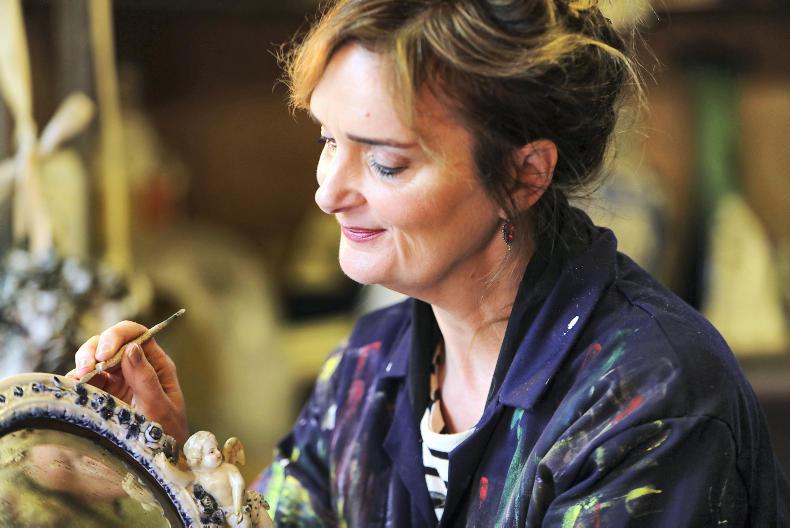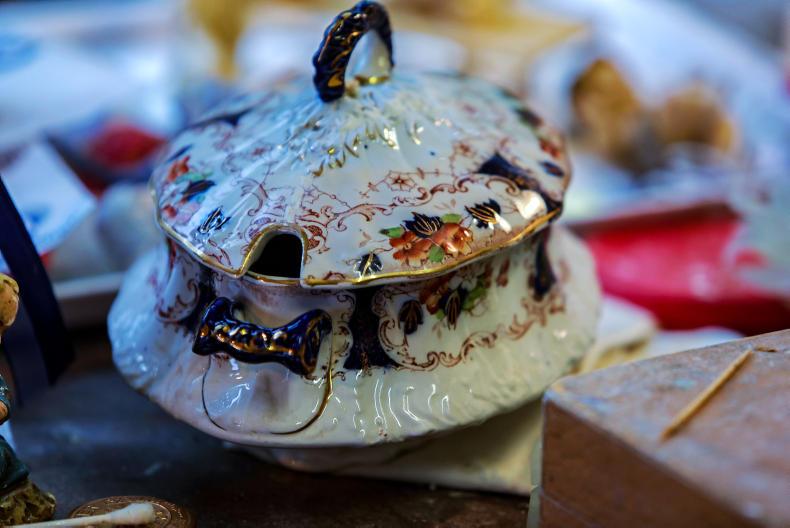"Growing up in Dublin, I didn’t have an ‘artistic’ background as such, but my dad was an engineer and he would have appreciated things that were well made. Maybe that spurred something in me?
“I originally trained as an interior designer and then I went to the London Academy of Fine Art to study the history of ceramics and stone. That sparked my interest in restoration.

"When I returned to Dublin, I trained and then worked with the renowned Desiree Shortt as a china and porcelain restorer. With Desiree, you learned to be perfect. When I am working on a piece, I do aspire to getting it like it hasn’t been damaged; that’s my ultimate goal. And that’s why it’s very time consuming.
“Today, I work in my studio on a dairy farm outside Castleisland, Co Kerry, where I live with my husband Seamus and our three sons – Charlie, Billy and Thomas. 
A lot of my business comes from word of mouth. Often, people will bring in sentimental pieces. It could be their mother’s or their grandmother’s vase that was smashed and that somebody might have made an effort to fix 10 years ago, but the glue has gone all brown, which is normal. They’ll say, ‘Oh this piece has no value, but I’d love to get it restored’. Or then there are the cases where someone has gone in to water their neighbour’s plants and low and behold, breaks something and is in a massive panic.
“I’ve had people come to me with bags of smithereens and I remember one man who put a big urn in my face one day and asked, ‘Is this beyond redemption?’ I thought that was a brilliant line – but I see these projects as a challenge.

“When it comes to porcelain, I’d get a lot of Iladró (a Spanish brand of collectible figurines). I’d also get a lot of Beswick (British ceramic) horses and they would be some of my favourite pieces to restore, because often they might be missing an ear, and you would have to sculpt that. It’s quite complicated when you go about it – it has to look and sit right. You can’t just land an ear on a horse.
“Making missing parts is actually my favourite part of restoration. If you have a piece that is missing a finger or a petal or two, just adding that back in completes it again.
I suppose I do have a grá for broken things. My heart kind of goes out to them.
“But I’ve also restored high-end antiques and recently, I did a very large mid-century fountain, as well as some Chinese porcelain for an auction. I’ve also got in everything from marble to ivory and it’s good to push yourself. One of my biggest jobs was restoring nine statues in Ballybunion Church; I was out there for six months. I especially enjoy painting the statues with light and shade, so that there is a bit of movement in them.”
A lonely career
“Restoration is a dying art in Ireland unfortunately. Some people give it up because the chemicals are quite harsh. 
You’ve got glazes and catalysts and they are quite strong. But with the location that I have for my studio, there is good ventilation, and I can bring pieces outside. I’m also very lucky that my eyesight is so good, especially when it comes to matching colours. Even if it’s just a little bit off, you can always tell.
“You’d want a radio though, doing this type of work on your own! I have an internet radio with 700 channels from around the world and I switch around: BBC4 or Women’s Hour in the morning and then something like Liveline or The Niall Boylan Show in the afternoon.

“When it comes to pieces that I would like to restore for myself, I love French porcelain and I have a few things that I need to work on; but I never see them getting done. My time is just eaten up. It’s like a cook that never cooks in their own kitchen.” CL
For more information, visit Susie's website.
"Growing up in Dublin, I didn’t have an ‘artistic’ background as such, but my dad was an engineer and he would have appreciated things that were well made. Maybe that spurred something in me?
“I originally trained as an interior designer and then I went to the London Academy of Fine Art to study the history of ceramics and stone. That sparked my interest in restoration.

"When I returned to Dublin, I trained and then worked with the renowned Desiree Shortt as a china and porcelain restorer. With Desiree, you learned to be perfect. When I am working on a piece, I do aspire to getting it like it hasn’t been damaged; that’s my ultimate goal. And that’s why it’s very time consuming.
“Today, I work in my studio on a dairy farm outside Castleisland, Co Kerry, where I live with my husband Seamus and our three sons – Charlie, Billy and Thomas. 
A lot of my business comes from word of mouth. Often, people will bring in sentimental pieces. It could be their mother’s or their grandmother’s vase that was smashed and that somebody might have made an effort to fix 10 years ago, but the glue has gone all brown, which is normal. They’ll say, ‘Oh this piece has no value, but I’d love to get it restored’. Or then there are the cases where someone has gone in to water their neighbour’s plants and low and behold, breaks something and is in a massive panic.
“I’ve had people come to me with bags of smithereens and I remember one man who put a big urn in my face one day and asked, ‘Is this beyond redemption?’ I thought that was a brilliant line – but I see these projects as a challenge.

“When it comes to porcelain, I’d get a lot of Iladró (a Spanish brand of collectible figurines). I’d also get a lot of Beswick (British ceramic) horses and they would be some of my favourite pieces to restore, because often they might be missing an ear, and you would have to sculpt that. It’s quite complicated when you go about it – it has to look and sit right. You can’t just land an ear on a horse.
“Making missing parts is actually my favourite part of restoration. If you have a piece that is missing a finger or a petal or two, just adding that back in completes it again.
I suppose I do have a grá for broken things. My heart kind of goes out to them.
“But I’ve also restored high-end antiques and recently, I did a very large mid-century fountain, as well as some Chinese porcelain for an auction. I’ve also got in everything from marble to ivory and it’s good to push yourself. One of my biggest jobs was restoring nine statues in Ballybunion Church; I was out there for six months. I especially enjoy painting the statues with light and shade, so that there is a bit of movement in them.”
A lonely career
“Restoration is a dying art in Ireland unfortunately. Some people give it up because the chemicals are quite harsh. 
You’ve got glazes and catalysts and they are quite strong. But with the location that I have for my studio, there is good ventilation, and I can bring pieces outside. I’m also very lucky that my eyesight is so good, especially when it comes to matching colours. Even if it’s just a little bit off, you can always tell.
“You’d want a radio though, doing this type of work on your own! I have an internet radio with 700 channels from around the world and I switch around: BBC4 or Women’s Hour in the morning and then something like Liveline or The Niall Boylan Show in the afternoon.

“When it comes to pieces that I would like to restore for myself, I love French porcelain and I have a few things that I need to work on; but I never see them getting done. My time is just eaten up. It’s like a cook that never cooks in their own kitchen.” CL
For more information, visit Susie's website.












 This is a subscriber-only article
This is a subscriber-only article










SHARING OPTIONS: